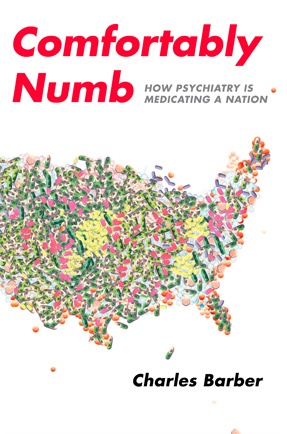
Comfortably Numb: How Psychiatry Is Medicating a Nation
by Charles Barber
For those who don’t remember the endearing Zoloft dot of the early years of this millennium, that blobby animated star of advertisements for the antidepressant, Charles Barber tells the story. It was one of the best among the many drug campaigns aimed directly at consumers, made possible by a loosening of Food and Drug Administration regulations in 1997. Marketing gurus invented the name “Zoloft” to sound vaguely scientific but still pronounceable (like its peers Prozac, Effexor, and Paxil, to name but a few). A famed animator invented the blob character (while drunk, apparently). The dot has a fan club, and would probably make an adorable plush toy. “The genius of the advertisement,” Barber writes, “is that it made the symptoms of depression cute, funny, and accessible.”
The Zoloft ad is a small example of the many factors that have made depression – and other mental problems, whether serious schizophrenia or relatively new inventions, like compulsive shopping disorder – not only normal, but nearly trendy. Barber, a counselor of the seriously mentally ill, investigates how this came to be. He explores the strategies of Big Pharma – namely, marketing snappily-named meds as cure-alls for anything that brings you down – and the enfeebling of the FDA. But he also points a finger at family doctors, psychiatrists, and patients. He condemns doctors who write slips too easily, and psychiatrists who condone the mushrooming number of officially diagnosable mental illnesses (like “antidepressant discontinuation syndrome,” the cure for which you can probably guess). Barber also takes on Americans’ uniquely broad notion of misery (including tangents on the closing of the frontier and the Declaration of Independence).
The story of the American obsession with cure-all pills might start with Valium, which gained popularity (and eventual notoriety for its addictiveness) in the 1960s. Prior to that, mental illness was mostly contained in asylums, with sometimes acceptable and sometimes brutal results. With Valium, Barber writes, “For the first time in history, it was okay to take psychiatric drugs. Simply put, you didn’t have to be crazy – that is, you didn’t have to be mentally ill – to take the pills.” (Emphasis his.) Valium, however, was never as big a hit as Prozac, the drug that made depression hip and launched an age, Barber notes, in which celebrities dish their diagnoses in highly publicized interviews and everyone from Tony Soprano to the kid next door pops pills.
Some good has certainly come of the normalizing of mental illness, as Barber admits, nor is our fascination with it so new – he cites Sylvia Plath as noting, while writing The Bell Jar, that “there’s an increasing market for mental-hospital stuff.” Criticism of the overuse of drugs is common (including in several other books), and new, fearful headlines appear regularly. Still, Barber makes a broader point: the real harm of these trends hits psychiatrists – as they try to tackle all life’s problems, while relying excessively on chemical and neurological treatements – and Americans, who opt for “emotional sanitation” rather than simple health. Most of the medicated are already clinically healthy, or can get there through methods that have fewer side effects and better results, like diet, exercise and cognitive-behavioral therapy. To the final method, Barber devotes a few dozen pages, praising the practice for its simplicity and its effectiveness, if not for its marketability. “CBT” may have an acronym, but it still doesn’t have a cute dot.
Excerpt: “Six years after its introduction, Valium became the most common drug in America. It remained so until 1982. In 1978, at the peak of its popularity, 2.3 billion pills were sold. Valium became so popular in the corporate world that it was known as ‘Executive Excedrin.’ In the 1960s and 1970s, Valium became a clinical and cultural phenomenon that presaged – though never rivaled – the Prozac Nation ’90s. The Rolling Stones had a hit song, ‘Mother’s Little Helper,’ about the use of pills by stressed-out housewives….”
Further Reading: Overtreated and Against Happiness: In Praise of Melancholy




Send A Letter To the Editors